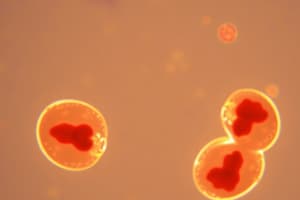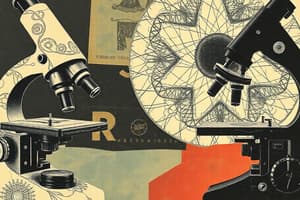Podcast
Questions and Answers
Which type of microscope is primarily used for observing very small objects or details?
Which type of microscope is primarily used for observing very small objects or details?
- Scanning electron microscope
- Electron microscope (correct)
- Compound light microscope
- Digital microscope
Ribosomes are responsible for storing proteins.
Ribosomes are responsible for storing proteins.
False (B)
What is the main function of mitochondria in cells?
What is the main function of mitochondria in cells?
To produce energy for the cell.
Lysosomes are organelles that are used to ________ cell matter.
Lysosomes are organelles that are used to ________ cell matter.
Match the following cell types with their primary function:
Match the following cell types with their primary function:
How many chromosomes do human body cells have?
How many chromosomes do human body cells have?
Chloroplasts are organelles found in both plant and animal cells.
Chloroplasts are organelles found in both plant and animal cells.
What stage of mitosis involves chromosomes lining up in the middle of the cell?
What stage of mitosis involves chromosomes lining up in the middle of the cell?
Which of the following is a characteristic of acids?
Which of the following is a characteristic of acids?
Light can travel faster than any known object in the universe.
Light can travel faster than any known object in the universe.
What is the primary color model used in additive color theory?
What is the primary color model used in additive color theory?
The formula for wave speed is v = f ƛ, where v is the wave speed, f is the __________, and ƛ is the __________.
The formula for wave speed is v = f ƛ, where v is the wave speed, f is the __________, and ƛ is the __________.
Match the following properties of light with their definitions:
Match the following properties of light with their definitions:
What type of color theory explains how we perceive colors through absorbing and reflecting light?
What type of color theory explains how we perceive colors through absorbing and reflecting light?
Phenolphthalein turns pink in acidic solutions.
Phenolphthalein turns pink in acidic solutions.
What is a light year's distance in terms of light travel?
What is a light year's distance in terms of light travel?
Which type of mirror always produces virtual images that are smaller than the object?
Which type of mirror always produces virtual images that are smaller than the object?
Concave mirrors can only produce real images.
Concave mirrors can only produce real images.
What is the formula for magnification in terms of heights of images and objects?
What is the formula for magnification in terms of heights of images and objects?
The bending of light as it passes from one medium to another is known as __________.
The bending of light as it passes from one medium to another is known as __________.
Match the following types of lenses with their respective functions:
Match the following types of lenses with their respective functions:
According to Snell's law, what is the relationship between the angle of incidence and the angle of refraction?
According to Snell's law, what is the relationship between the angle of incidence and the angle of refraction?
Which blood vessels carry oxygenated blood away from the heart?
Which blood vessels carry oxygenated blood away from the heart?
Total internal reflection can occur when light travels from a less dense medium to a more dense medium.
Total internal reflection can occur when light travels from a less dense medium to a more dense medium.
Veins carry oxygenated blood away from the heart.
Veins carry oxygenated blood away from the heart.
The equation for the index of refraction is given by n = __________ / v.
The equation for the index of refraction is given by n = __________ / v.
What is the charge and mass of a proton?
What is the charge and mass of a proton?
The __________ is responsible for facilitating the absorption of oxygen into the blood.
The __________ is responsible for facilitating the absorption of oxygen into the blood.
Match the following types of chemical reactions with their definitions:
Match the following types of chemical reactions with their definitions:
What term describes an atom that has gained or lost electrons?
What term describes an atom that has gained or lost electrons?
A heart murmur is caused by healthy valves functioning properly.
A heart murmur is caused by healthy valves functioning properly.
What is the main role of the respiratory system?
What is the main role of the respiratory system?
An ionic compound forms between a metal and a __________.
An ionic compound forms between a metal and a __________.
Which of the following is true about the Law of Conservation of Mass?
Which of the following is true about the Law of Conservation of Mass?
Flashcards
Electron Microscope
Electron Microscope
A powerful microscope that uses beams of electrons to create images, allowing detailed viewing of tiny objects or structures.
Mitochondria
Mitochondria
An organelle within the cell responsible for producing energy (ATP) through cellular respiration.
Mitosis
Mitosis
The process of a cell dividing into two identical daughter cells, ensuring each cell has the same genetic material.
Prophase
Prophase
Signup and view all the flashcards
Metaphase
Metaphase
Signup and view all the flashcards
Anaphase
Anaphase
Signup and view all the flashcards
Telophase
Telophase
Signup and view all the flashcards
Stem Cells
Stem Cells
Signup and view all the flashcards
Chemical Digestion
Chemical Digestion
Signup and view all the flashcards
Circulatory System - Function
Circulatory System - Function
Signup and view all the flashcards
Blood Flow Through the Heart
Blood Flow Through the Heart
Signup and view all the flashcards
Arteries
Arteries
Signup and view all the flashcards
Capillaries
Capillaries
Signup and view all the flashcards
Veins
Veins
Signup and view all the flashcards
Atom
Atom
Signup and view all the flashcards
Bohr Diagram
Bohr Diagram
Signup and view all the flashcards
Ion
Ion
Signup and view all the flashcards
Ionic Compound
Ionic Compound
Signup and view all the flashcards
Refraction of light
Refraction of light
Signup and view all the flashcards
Index of refraction (n)
Index of refraction (n)
Signup and view all the flashcards
Optical density
Optical density
Signup and view all the flashcards
Total internal reflection
Total internal reflection
Signup and view all the flashcards
Converging Lens (Convex Lens)
Converging Lens (Convex Lens)
Signup and view all the flashcards
Diverging Lens (Concave Lens)
Diverging Lens (Concave Lens)
Signup and view all the flashcards
Thin Lens Equation
Thin Lens Equation
Signup and view all the flashcards
Farsightedness (Hyperopia)
Farsightedness (Hyperopia)
Signup and view all the flashcards
Linear Propagation of light
Linear Propagation of light
Signup and view all the flashcards
What is light?
What is light?
Signup and view all the flashcards
Electromagnetic Spectrum
Electromagnetic Spectrum
Signup and view all the flashcards
Visible Spectrum
Visible Spectrum
Signup and view all the flashcards
Speed of Light
Speed of Light
Signup and view all the flashcards
What is a light year?
What is a light year?
Signup and view all the flashcards
Additive Color Mixing
Additive Color Mixing
Signup and view all the flashcards
Subtractive Color Mixing
Subtractive Color Mixing
Signup and view all the flashcards
Study Notes
Biology Review
- Microscopes:
- Compound light microscope is used in class.
- Electron microscopes are more powerful for tiny details or living things.
- Scanning electron microscopes are used for 3D objects.
- Parts and functions of the compound light microscope.
- Diagram of cell organelles (e.g., cell membrane, ribosomes, Golgi apparatus, mitochondria).
- Animal and plant cell organelles are labeled.
- Mitochondria are crucial energy-producing organelles.
- Lysosomes break down cellular material.
- Golgi bodies store proteins.
- Ribosomes make proteins.
- Cell Division (Mitosis):
- Stages of mitosis (interphase, prophase, metaphase, anaphase, telophase).
- General details of each stage.
- Interphase is the normal cell life cycle with DNA replication.
- Prophase: DNA thickens, chromosomes pair up, becoming visible.
- Metaphase: Chromosomes line up in the center of the cell.
- Anaphase: Chromosomes separate and move to opposite poles.
- Telophase: New nuclear membranes form, cytoplasm divides to create two daughter cells.
- Human cells have 46 chromosomes (23 pairs).
- Sex cells typically have 23 chromosomes (single set).
Cell Types Summary
- Nerve Cells: Carry electrical signals.
- Red Blood Cells: Carry oxygen.
- Cardiac Muscle Cells: Cause heartbeats.
- Smooth Muscle Cells: Involuntary muscles.
- Stem Cells: Unspecialized, able to become different body cells.
Body Systems
- Digestive System: Includes all organs and digestive processes.
- Digestive Process Overview: Mechanical vs. chemical digestion, ingestion, digestion, absorption, egestion.
Chemistry Review
Atom Structure
-
Structure of the atom: protons, neutrons, and electrons in the location with each charge and mass.
-
Bohr Diagrams: atoms with the same number of protons and electrons.
-
Ions: atoms that gain or lose electrons.
-
Ionic Compounds: formed between metals and non-metals.
-
Atomic Number: number of protons.
-
Mass Number: sum of protons and neutrons.
-
Chemical Formula Example: MgCl2, Al2S3
Chemical Reactions
- Chemical Reaction Types: Synthesis, decomposition, single replacement, double replacement, and combustion.
- Counting Atoms: Examples such as C6H12O6
- Balancing Equations: principle of conservation of mass.
- Chemical equations: balancing equation for different chemical reactions.
Light and Optics Summary
- Light Properties: Light is electromagnetic radiation; it travels as a transverse wave, behaves as a particle, and travels in straight lines.
- Electromagnetic Spectrum: Visible light is a small part of the wider spectrum of electromagnetic radiation.
- Wave Equation: Relationship between wave speed, frequency, and wavelength.
- Color Theory: Additive (mixing lights) and subtractive (absorbing colors) light mixing, and relationships.
- Sources of light: types of light and how light is produced.
- Reflection and Refraction: Properties like reflection (diffuse and regular) and refraction are associated with light and how it reacts at various interfaces.
- Mirrors and Lenses: Features, usage, ray diagram construction, and image characteristics.
Other Important Concepts
- Thin Lens Equation: 1/f = 1/di + 1/do for calculating image and object distances with lenses.
- How Lenses Improve Vision: How corrective lenses are designed according to the thin lens equation.
Studying That Suits You
Use AI to generate personalized quizzes and flashcards to suit your learning preferences.




